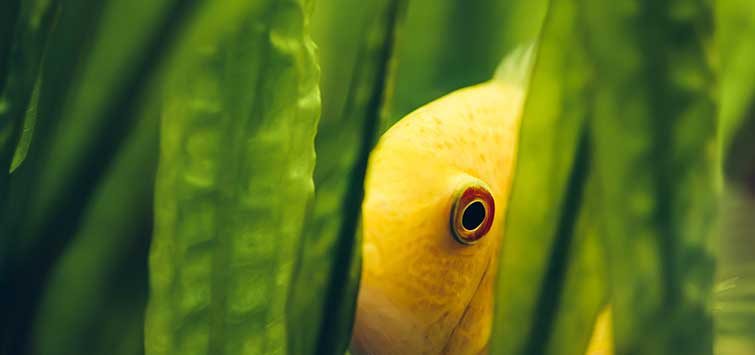The Planted Tank: Dealing With Success
The Planted Tank: Dealing With Success
Author: Rhonda Wilson
Once you have your planted aquarium successfully running, you’ll soon find yourself faced with problems resulting from your good fortune, and wondering what to do with all the excess plants growing in your tank.
At first it’s simple. You trim the plants and put most of the trimmings back in the tank to create more plants. But eventually you find that your tank is just plain full and there’s no place left to put the trimmings. Congratulations! You’ve reached a new level of success, and those trimmings have real value.
TRADE YOUR EXTRAS
Excess plants and stem-plant trimmings can be turned into trade or cash value. You won’t be able to quit your day job, but you can turn in some trimmings for new plants, fish, or equipment for your aquariums. This can usually be done at your local fish store. Be sure to check with the owners before bringing plants in. Some stores are relatively open to trades, but other stores have policies that don’t allow for them. Large chain stores usually don’t accept trades, but many of the smaller independently owned stores will. Each store has its own policy, but I’ve found that those that do offer trades usually will offer you a percentage of the value of the plants in exchange for store credit.
Remember, the store is looking for products that will actually sell, so the plants they will accept have to be of reasonably good quality. These plants should display nicely; the leaves should be full and lush, and there should be multiple stems in bunches of stemmed plants. A store will usually want several of the same plant rather than just one or two. The more ready the plant is for sale, the happier the store will be to work with you. Your knowledge of your product will help also. Know the scientific and common names of your plants and how to spell them, and know what conditions your plant grows best in so the store employees will be able to pass that information on to their customers.
Being polite and doing business at times that the store is less busy will also tend to help make your trades more favorable to the store owners and managers. Remember they are still trying to do business with other customers and you’re trying to sell them something. Your attitude will go a long way in determining what sort of relationship you’ll have with your store. Good relationships with an attentive store staff can be very helpful in getting you the latest information and products, calls when something you might be interested in arrives, and better trades, discounts, and service.
PLENTY OF OTHER OPTIONS
Another great way to deal with your unwanted excess plants is give them to other hobbyists. Whether you’re encouraging a new hobbyist to try plants, or helping experienced fishkeepers fill their bare tanks with plants, getting new people to grow plants is a rewarding way to dispose of extras. Children, schools, and friends often have aquariums and are happy to have a few extra plants now and then. Encouraging other hobbyists and watching their delight in seeing their new plants grow can be emotionally rewarding.
Trading plants is a great way to meet other hobbyists and increase your own collection of plants or fish. You can trade with people locally or through the mail. Plants are easily shipped when well packed.
As the aquarium planting hobby has gained in popularity in recent years, local clubs have sprung up around the country. In our local plant group we generally bring in our cuttings and have a free-for-all, first-come-first-served sort of trade. There’s usually not a problem in getting everyone a share of whatever is being offered. In other plant and aquarium clubs, live auctions are a fun way to sell and purchase plants or fish. In national groups, huge quantities of rare and exotic plants can be found in day-long auctions.
Another way to sell your excess plants is through online auctions. Large general-interest auction sites often have plants, but smaller, hobby-specific sites like aquabid.com are another great way to sell excess plants. Of course, if you offer plants for sale on auctions you have to research where and how to ship the plants before you actually sell them. It’s often a good idea to buy a few things through an online auction before you try selling in one. This will allow you to earn performance points and learn about the standards and expectations that are in place.
SHIPPING PLANTS
Whether in trade, as a sale, or as a gift, if you are going to ship aquarium plants you have to do your research first. Before shipping, first make sure that the plants you intend to ship are legal. Not only is there a national list of noxious weeds, but there are also separate lists for each state. Be sure that the states you are shipping from and to allow the transportation of the plants you intend to send.
Ship healthy plants, and send them as soon after removal from their original tank as possible. Make sure you’ve advised the buyer of snails, possible fish eggs, algae, or anything else they might want to know about. Also make sure they know the box is coming so they’ll be prepared.
There are many ways to ship your plants. In the past I’ve rolled them in old newspapers, then placed them in bags; I’ve also just placed them directly into bags. It’s probably easier to just put them directly into bags as long as the bag is relatively full to keep them from being jostled too much. Be sure you use appropriate bags; those made specifically for shipping and transporting fish are also the best ones to use to transport or ship plants. Be sure to use a good rubber band to secure the top.
It’s best to leave some air in the bags, but for short and extreme situations you can compress the bags and ship them pretty much flat. I’ve done this when trying to get a lot of plants back in a small piece of carry-on luggage. Remember, though, the plants were only in those conditions for less than 12 hours; for regular shipping I would leave air in the bags. On the other hand, make sure the bag isn’t too filled with air. You don’t want it like a balloon or it may pop under different air pressure changes that may occur in shipping. You want your bags to be mostly full, but to also have some give.
I like to ship plants and fish in insulated foam boxes, but a well-packaged regular cardboard box can be used to ship plants as long as it’s well padded and the trip won’t be too extreme in temperature. The insulated boxes do add peace of mind, and I would recommend using them whenever possible. Make sure appropriate padding is used. Packing peanuts and bubble wrap are good for packing around plants. Make sure the plants aren’t too tightly or loosely packed, as you don’t want to squish them or have them flying around the box.
Remember that, unlike fish, in most cases plants can be shipped without water, as long as the leaves are damp and the plants are in sturdy plastic bags. This makes them much easier to ship. Usually priority mail is an inexpensive and appropriate way to ship your plants.
DON’T DUMP YOUR PLANTS!
There are many ways to give your excess plants away, but sometimes none of these options may work for you. Then what should you do? If you can’t get your extra plants to other aquarists in some way then the only thing you can do is destroy the plants. They must be thrown away in such a way that they won’t be able to get into your local natural landscape.
Several aquatic plants have made it on to the Federal Noxious Weed List. These plants have found their way into natural ecosystems where they weren’t originally. This has become a major problem both in this country and around the world. Sometimes animals or plants have been released by governmental agencies with particular purposes in mind; sometimes they come from ponds or gardens and escape unintentionally in to the wild. And sadly, sometimes animals or plants are released by misguided owners.
People may sometimes think that their unwanted pets or plants can be set free to take care of themselves. Unfortunately what usually happens is the released organism either dies because it can’t cope with the wild surroundings or it finds that it likes the new surroundings very well, and since there are no natural predators it becomes invasive.
Invasive plants and animals destroy local ecosystems, driving out or killing the native inhabitants. They also cause damage to economic interests. Particularly in the area of aquatic plants, there are problems with waterways becoming clogged, sometimes to the point of interfering with hydroelectric plants. Floating invasive plants can cover natural waters, keeping sunlight from plants below, which die off. Eventually they can even cause oxygen depletion and fish deaths.
I’ve been happy lately to see several retail pet suppliers posting notices on their websites, and even sometimes on the plastic bags in which fish and plants are carried home, reminding people to never release their pets or plants. Remember to never release plants or animals in to the natural environment. For more information you can check Habitattitude at http://habitattitude.net .
AN ADDED BONUS
Once you get to the stage where your excess plants are a problem, you can really pat yourself on the back for being a successful aquatic gardener. Having extra plants to give away, sell, or trade is really an added bonus. While you won’t get rich on your extra plants, they are a nice way to meet fellow hobbyists, share and trade for new plants, and get a little extra cash for your hobby.

.png?h=595&iar=0&w=2781&hash=5FD5E69473BCC22199FBFA2FB71B6033)

